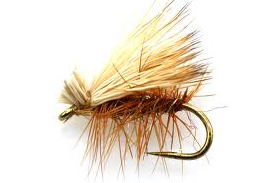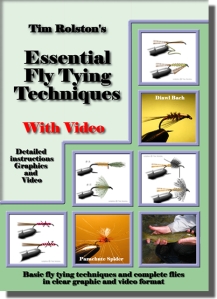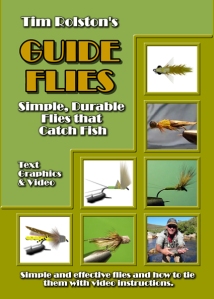The C-Word: CONFIDENCE.
I have been tying a lot of flies recently, mostly with a forthcoming trip in mind. The trip will take me back to waters I haven’t fished in four decades and as a result I have been researching more than a little on hatches, fly patterns and all things related.
I like tying flies and I like going on a trip with boxes full of newly minted patterns to cater, one hopes, for any eventuality, it is all part of the process. But it does strike me that when you look at all the different fly patterns out there one would have to consider the possibility the trout would pretty much eat anything at some point in time. One has to ask the question if it is possible to tie a fly that is so poor that a fish wouldn’t eat it.
Given the numbers of artificials one could be forgiven for imagining that you could be wrong all the time or equally that there is no wrong and the fish will eat whatever you have tied on the line if properly presented.
So what to do if you are on some strange water without too much of a clue? The answer to my mind is to fish something generic that could be “all things to all fish”. I can’t be alone in this thought process, the propensity of Hare’s Ear Nymphs, Pheasant Tails, Adams Dries and Elk Hair Caddis patterns in everyone’s fly boxes around the world suggests that we all come back to a similar solution to the problem. You pick something that is a reasonable facsimile, a pattern in which you have confidence and then fish it with care, because confidence in fly fishing really is the ultimate “C-Word”, it matters not one jot if your mate likes this fly or that fly, this wing or that wing, if you don’t have confidence in it the darned thing won’t work for you.
My mate Mike regularly fishes, amongst his team of three flies on a lake, an olive soft hackle pattern, and more to the point catches fish on it. I have used the darned thing, casting it for hours, hooking fish on the other patterns on a three fly rig without a single sniff from a trout to that fly. It just doesn’t work for me and the more it doesn’t work the less confidence I have in it, and the less confidence I have in it the more it doesn’t work.
As a general rule when tying flies, if I am not excited about the prospect of fishing them as they come off the vice they go into the recycling jar. The recycling jar nominally allows me to cut off the dressing and reuse the hook, in reality most of the flies go to other anglers, school kids with limited budgets and such who might appreciate them. The rub is they will probably catch fish on the things, but if the fly doesn’t excite me coming off the vice it isn’t going to get used and will sit quietly rusting away in the corner of a flybox until it is eventually turfed out to make space for something more useable and less tarnished.
We are all different, for some a precise imitation begets confidence, for me most of the time at least, delicacy of the fly gives me faith that it will work, delicacy in a dry fly and movement in a subsurface pattern. I could very well be the only fly angler alive who has no confidence in Woolly Buggers, I strongly dislike them, I really do. I don’t understand what they are supposed to be and so I don’t understand how to fish them. Actually I think that here at home they mostly get taken by the fish because they think that the fly is a dragonfly nymph, but then I would as soon tie on a dragonfly nymph pattern, in which I have a great deal of faith. Other anglers with a different viewpoint see the woolly bugger as the catch all “everything to all trout” kind of fly and do well with it. For me the Velcro Brushed Hare’s ear nymph is probably about as near to a universal subsurface pattern as any, the shaggier the construction the better.
So how much of it is about the fly? I am convinced that much of the time not a great deal at all. But your confidence in the fly, well that is a different matter entirely. It isn’t simply mystical, if you are confident you cast more carefully, retrieve with purpose, maintain concentration, fish slower, move more carefully. In short your fishing style changes when you are confident and confidence can be the most elusive of on the water emotions.
There is however an oddity to this discussion, a fly which has never worked for you previously, a fly in which your faith is extremely limited can become a favourite almost instantly should it prove successful, even only once.
On the streams we mostly fish with one fly at a time, so it takes some commitment to make a radical change to the fly pattern, away from those in which one has untold confidence. On a lake and bobbing about in a boat we generally fish three flies and so the trauma of testing a previously none productive pattern isn’t quite as great. Then when that fly takes fish your confidence builds and before you know it you have a “new favourite”.
I like to carry a lot of flies, probably too many to be honest but the confidence that it gives me to know that I could cover almost any eventuality gives me confidence, even though 80% of the flies rarely see the light of day, never mind approach becoming intentionally damp.
In various parts of the world different things seem to be valued as confidence builders, the hot spot in a Czech nymph is paramount for some people, the inclusion of real jungle cock in a pattern is another obvious affectation the lack of which will cause some anglers to simply pack up and go home. I personally have less confidence in parachute dry flies with bright fluorescent posts because I am convinced that they result in more refusals from the better fish, other anglers cast them with alacrity. There are fly tyers who will dye and blend their own mixtures of furs and feathers because they are seeking a specific colour and have remarkable blind faith in such and I have had one client in a past life who wouldn’t fish an Invicta but that it had a red tail instead of the traditional yellow one of Golden Pheasant Crest. There are those who consider that a damselfly nymph imitation should have red eyes despite the fact that there isn’t a whole lot of evidence that real damsels are kitted out with similarly bright opthalmics. It is all a bit odd and doesn’t make a whole lot of sense except for the fact that if you are confident you fish better and if you fish better you catch more.
One of my favoured patterns on our local streams is an absolutely minute brassie, a fly so lacking in physical presence that I generally don’t tell the clients that I have tied it onto the tippet. If they see the fly before they catch a fish they have no confidence in it at all, so I wait until we get a hook up and then say something along the lines of “do you want to see what that fish ate?”, something generally then followed by gasps of surprise from the angler.
Confidence isn’t easily obtained but there are certain criteria for most of us which help nail down this ephemeral emotion. Preparation leads to confidence, having lots of flies, practising knots, carrying spare leaders, having waterproof (as opposed to leaking) waders, being able to cast well, knowing the water, fishing a lot, reading a great deal.. all those things lead to a state of relative confidence and that will in turn catch you as many fish as all the fancy and complicated accoutrements, which the tackle industry might care to throw at you.
In the end I suspect that is why many of us, and probably all of the best anglers tie their own flies, it may not be that their own flies are better than any others, but they do give confidence and that is a good enough reason for all the slaving over a hot vice.
If you are a neophyte fly tyer you will probably start out, as indeed did I, with a lack of confidence in your own flies, but in time that will change and the commercial ones will lack the allure they once held.
Here are a couple of great resources if you want to start tying flies, tie better flies or perhaps gain confidence in tying and fishing them.
Essential Fly Tying Techniques: A eBook on critical tying techniques which will help you tie more effective and durable patterns.
Download from Inkwaziflyfishing
Order on disc from outside of South Africa
Guide Flies: A book and eBook available currently on disc and in printed format covering the flies that give me the most confidence. How to tie simple, durable and effective flies that really work.
Order a copy on compact disc.(South African Clients)
Order a copy of the softcover version (South African Clients)
Order either from outside of South Africa
As always feedback in the form of comments is most welcome, what flies bring you confidence? Are you as happy with a commercially fashioned pattern as ones of your own manufacture? Have fun out there and remember that if you have confidence then half the battle is already won.










